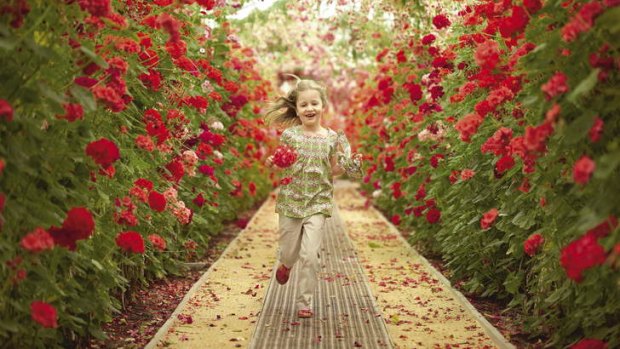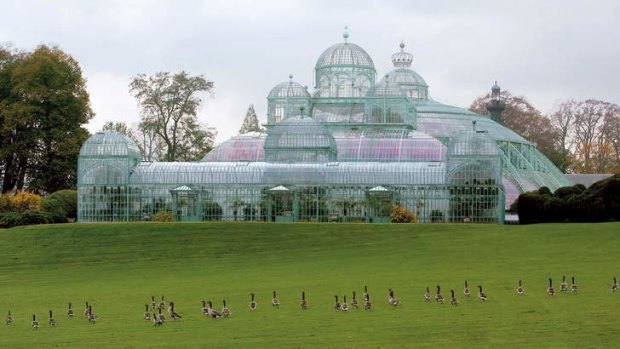
Princess Elisabeth of Belgium in the Royal Greenhouses, Brussels.Credit: Corbis
The beautiful royal gardens are about to throw open their greenhouses to the public for their yearly three-week stint, writes Kate Farrelly.
The brainchild of a greedy king obsessed with exotic plants and an architect on the cusp of a new era in architecture, the Royal Greenhouses of Laeken are among the world's greatest.
Every year in spring these spectacular structures in the private gardens of the Belgian royal family are open to the general public for a fleeting, three-week period. For a trifling $3 you can meander through the 2½-hectare complex, mouth agape at the utter indulgence exercised by King Leopold II back in the late 1800s.

The Royal Greenhouses, Brussels.Credit: Corbis
Located in the park of the Royal Castle of Laeken in Brussels, Belgium's capital, the greenhouses are bursting with spring blossoms and countless plants from far-flung countries. They march down a gentle slope covering a distance close to 1 kilometre. It's worth wearing your walking shoes as you wind your way through the interconnected "glass city". You might spend longer still if, like me, you feel compelled to snap a photo of every gorgeous flower you come across.
We arrived early and did not encounter the maddening queues I had heard about, although the crowds swelled as the morning progressed. But nothing could spoil the pleasure of this dream-like botanical bounty, far removed from the chocolate-chomping and beer-guzzling pursuits offered elsewhere in Brussels.
Of course, you don't need to be botanically-minded to enjoy your visit. It's the supreme lushness of the flora and sheer audacity of the architecture that makes the greenhouses such a popular attraction with the locals.
In the Great Gallery there are walkways filled with climbing geraniums where a multitude of fuchsia varieties create a floral canopy overhead. The Azalea House offers up a profusion of multicoloured blooms, and in the Orangery many of the citrus trees are more than 200 years old. The Embarcadere greenhouse is home to large oriental pots collected by Leopold in the Far East and now filled with Malaysian orchids. The collection of over 100 species of camellia is said to be the oldest and largest of its kind.
The centrepiece of the complex is the enormous Winter Garden greenhouse with its 25-metre-high dome, topped by a lantern and a giant crown. A circular, stone colonnade of 36 columns supports the metal framework. Inside you'll find dozens of different palms, from the towering Australian cabbage-tree palm, which grazes the top of the dome, to the ornamental Mexican fan palm. Leopold bought many of the original palms from private Belgian collections and had them transported on railway wagons drawn by 20 horses plodding through the night.
From the outset, this greenhouse was designed for royal receptions. With visitors today ambling about in jeans and cardigans, it's a little difficult to imagine the pomp and ceremony that would have accompanied the Winter Garden's inauguration in 1880 to mark the engagement of Leopold's daughter to the heir apparent to the Austrian throne. The 200-strong Vienna Men's Choir performed for the royals and their guests in the exotic confines of this extravagant indoor garden.
Today there are 20 full-time gardeners caring for the greenhouses. For those who know their azaleas from their hydrangeas, you'll appreciate the lengths to which the staff go to orchestrate spring flowering from hundreds of different plants. First they must endure a cold period from October to December then, in the depths of the Belgian winter, they are treated to a summer holiday: three weeks of warm temperatures to encourage buds that will eventually open for visitors in April.
Equally impressive is the work of Alphonse Balat, the architect responsible for most of the greenhouses. With the industrial revolution making possible the mass production of glass, iron and steel, Balat abandoned his more classical approach for building methods that were cutting edge in his day. Walking through the greenhouses, which are connected by glassed-in corridors, Balat's ability to harness space and light is showcased in each seemingly delicate web of iron and steel.
To truly appreciate your visit, it's worth doing a little digging on Leopold before you go. You'll discover this tyrant funded much of the work on the greenhouses through atrocities that some historians say rival Hitler and Stalin. He established the Congo Free State under his own personal rule and amassed a huge personal fortune by exploiting the area for its ivory and rubber, committing human rights abuses in the process. Leopold spent some of his fortune commissioning the Royal Greenhouses, built as an extravagant trophy cabinet of sorts for the plants he collected, as well as housing a dining hall, theatre, chapel and reception areas.
It's a little unnerving to find yourself admiring the blooming brilliance of the greenhouses having unearthed their history. But Leopold's legacy is here to stay and it seems only fitting that the public get to share in this significant Belgian masterpiece.
Trip notes
Getting there Thai Airways flies from Sydney to Paris via Bangkok daily from $2058. 1300 651 960, thaiairways.com.au. Euro Railways has fast trains from Paris to Brussels from $140 one way.
Visiting there This year the gardens are open from April 20 until May 12. Visiting hours vary so check opt.be before you go.
Staying there Aloft Brussels Schuman, Place Jean Rey, Brussels, from $97. +32 2 800 0888, starwoodhotels.com.
Sign up for the Traveller Deals newsletter
Get exclusive travel deals delivered straight to your inbox. Sign up now.